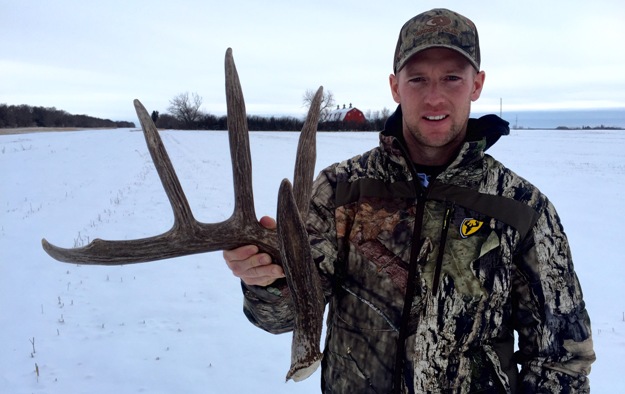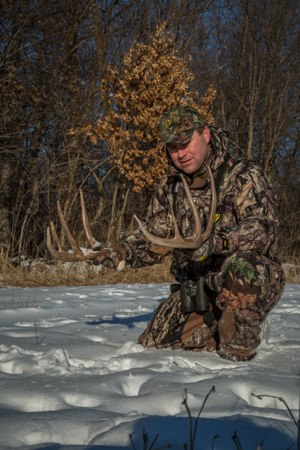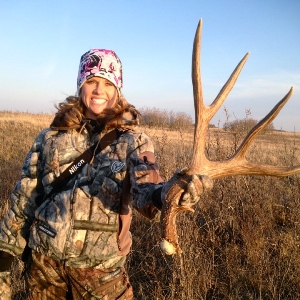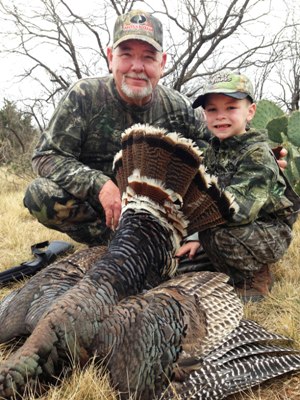by Jason Herbert

I'll never forget the sight. More of an excuse to get my kids out of the house than anything, our “shed” hunting trip didn't last long. But it didn't need to either. Barely peeking out of a fresh crust of snow, two tiny tines were reaching out toward the sky. I hollered loudly for my dad and sons - similar to how I get everyone's attention when the first morel mushroom of the season has been found. “Guys, check it out, my first shed.” The boys- both quite young, were less than impressed, but my dad thought it was pretty cool. A small forkhorn shed, from a buck we passed all season long. With a bit of fresh blood and hair on the pedicle, I could tell it hadn't been off for long. I think God wanted me to become a shed hunter because he certainly blessed me with the gift of that shed antler. As soon as I touched it I felt something primal. Man has been obsessed with antlers for countless generations and being the first human to hold this antler felt amazing. Ever since then, I've tried to learn as much as I could to become a better shed hunter.
Working with ScentBlocker has allowed me many cool opportunities. They've flown me around the world, and helped me make new lifelong friends. I've had a chance to work with most of the big celebrity's in the outdoor industry, and learned a lot from them along the way. Recently when talking about spring content, I suggested shed hunting. I know for a fact I'm not the only one out there who is interested in learning more about this sport. Shed hunting is becoming an international obsession, and for good reason. Everyone can be involved, and it can be as challenging or easy and one makes it. Not only are shed antlers from all sorts of animals worth a lot of money, but hunting for them is a great way to involve the family, and like I did with my kids- get everyone outdoors for some fresh air and exercise.
 Cody and Kelsy Robbins- Live2Hunt
Cody and Kelsy Robbins- Live2Hunt
Hailing from the frozen north, Cody and Kelsy Robbins call Saskatchewan home. Due to the overwhelming and dangerous amount of snow the Robbins' receive each year- they often take a unique approach to shed hunting. Equipped with snow mobiles, the Robbins' shed hunting team takes to the fields and forests while riding the machines. Then with high quality optics, when they do spot a shed, they simply drive up to it and retrieve. Often the show is very deep, where the animals can walk on it, but humans may sink deep. Cody starts his hunt for sheds a bit earlier than most, but being way north in cold Canada allows for it. Generally the animals shed earlier the farther north they are, so Cody and Kelsy get a head start on everyone else. Cody starts his hunt for sheds where the animals were eating, and works his way out from there. He doesn't always have to use a snowmobile, but prefers to because he can cover a lot more ground that way.
One story I heard about Canadian shed hunting sounded almost too good to be true... but I know it is. A local cattle rancher had a huge pile of hay out. The local deer were not only eating the hay, but living on it! Needless to say, once shed season started many antlers were collected around the pile of hay. With the potential for elk, moose, whitetail and mule deer antlers, I hope to shed hunt Canada one day.
Tyler Zygmunt- Professional Trapper
Also calling Canada home, Tyler Zygmunt is a modern day mountain man. Among many other things, Tyler is a professional trapper. I assumed Tyler sold all of the sheds he finds, but I learned that's not the case. “I don't sell them, it's one of those things that I just love to do, everything I find comes down in my basement and I keep on collecting. It is hard here because we don't have the deer numbers here like you guys do there, and our moose numbers are not the greatest right now either. But I keep plugging away and it'll happen. I love finding antlers; it gives me a boost knowing that the animal made it another year, moose or deer. Nothing beats the fact of knowing monster moose like this made the most of the winter and are likely going be around next year! So many wolves around it's really amazing that they do make the winters. I'm trying to help the whole wolf problem!
Tyler is one heck of a trapper and moose hunter too, and continuing to do his part to make sure he has more moose and deer sheds to hunt each winter by controlling the predator population.
 Pat and Nicole Reeve- Driven TV
Pat and Nicole Reeve- Driven TV
Pat Reeve has taught me more about shed hunting than anyone else combined. Pat and Nicole are a wealth of hardcore deer hunting information, and every time we speak I try to adsorb as much of their wisdom as possible. “The first step to finding a lot of antlers is to locate where the deer are feeding during shedding season.” Pat Reeve's logic makes a lot of sense, yet many overlook it. Each winter lots of well meaning shed hunters continue their fruitless searches in bedding and feeding areas that were popular during the fall. Unless the preferred winter food source is also the fall hunting area, the chances of the deer still being there are slim. We recommend starting to look right where the deer were feeding. Fresh sign, droppings, and of course trail camera evidence will confirm what the deer were eating. Possible food sources could be grain fields, (harvested or standing) oak flats, hay fields, fruit orchards, etc... Each property will be different.
Once the preferred winter food source has been located, the next step is to find where the deer are bedding. By “backtracking” the trails to their recent bedding areas, many sheds can be found along the trail. Often the path to the food isn't an easy one, with possible fence jumps, creek crossings, or steep hills to maneuver. Whenever the bucks have to jump, duck, or run they might jostle an antler off as well. When looking for sheds on trails, pay particular attention to obstacles that might jar the animals head or bang the antlers on something.
Lastly, Pat and Nicole recommend scouring the bedding areas for antlers. Although the trail may be obstructed, most winter bedding areas will not be far from the food. A decent winter bedding area needs to offer enough cover to protect the animals from the weather. In the winter months deer like to use as much of the sun's warmth as possible. Look for winter beds on south facing slopes as well as in thermal cover such as spruces and cedars. Pat said it best, “My ideal winter bedding area would be a southern slope with cedars. If you can find that, there will be sheds nearby.”
Aaron Zimmerman- New Bearing Media
A bit further south- and still in the heart of big whitetail country, our next pro Aaron Zimmerman calls central Ohio home. Aaron is generally hunting small pieces of property, with a high amount of hunting pressure. “Where I have had the most success is looking in any areas where deer congregate. I spend the most time in staging areas, feeding areas, main travel routes, and bedding areas. I don't waste time zig-zagging for the off chance of finding a shed. Where possible I will get a high vantage point on a cut bean field or corn field and glass for sheds. Knowing where the herd beds, I will watch my trail cameras until a buck shows up after shedding. Once I see that I will just walk the trail back to his bedding area and will typically find them along the way. I'm careful to only go into a bedding area one time during late February. Whether I find any sheds or not, I will not go in again.”
Aaron's logic and strategy also make a lot of sense for his location. It is especially important on small properties to not look too early and risk bumping deer that haven't shed yet off of the property. I personally have bumped antlered deer out of their winter beds and watched them run away, kicking myself for now having no clue where they'll drop their racks.
Shed hunting is an absolute riot, and a great way to beat cabin fever. Not only is it a great excuse to get outside, but it's a great time to invade bedding areas with little or no consequence while formulating a plan for the next season. So get out this winter and try shed hunting, and when you find your first shed, or your hundredth, be sure to send us pictures.



























